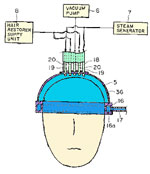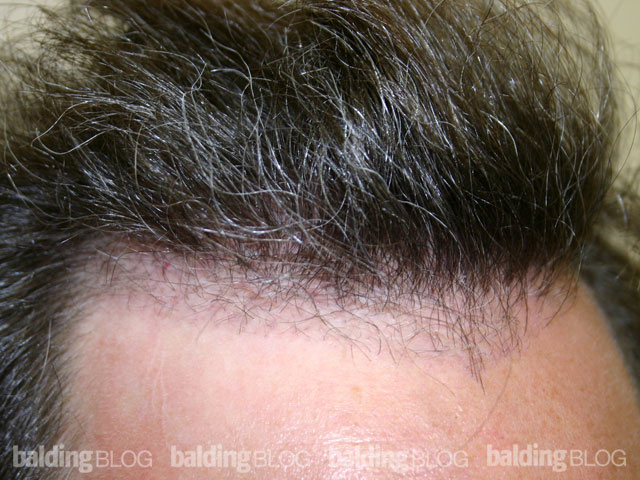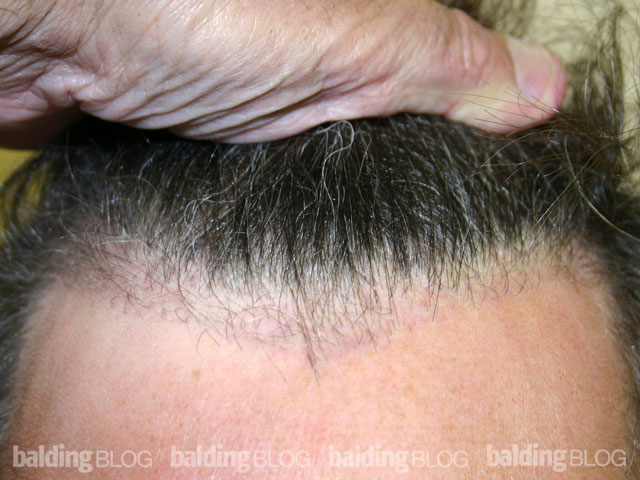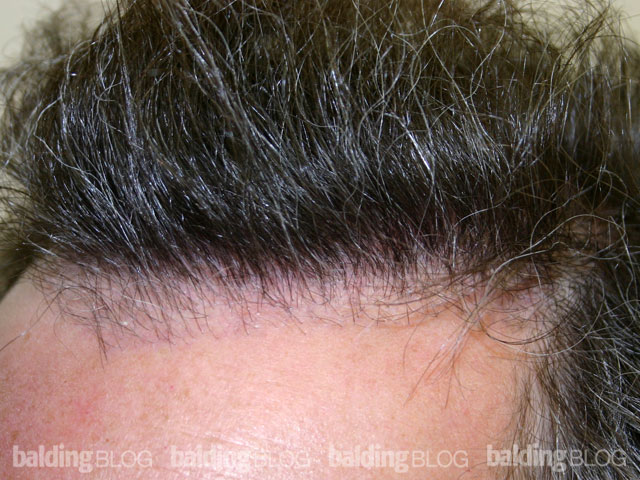Meet Patient NG, a man in his 30’s with slightly wavy, black hair. He had 3 procedures at the New Hair Institute totaling 7,470 grafts. The video was shot just days after his 3rd procedure (1833 grafts), so the hair had obviously not grown in yet, but you can hear for yourself just how much having a nice head of hair has changed his life. Please enjoy.
Look at this monstrosity called Hot Head that I found while looking at a site about stupid patents! I would not be shocked to learn that if this came to market some desparate dudes would try this thing just because it claimed to work, just like the generic Propecia people buy thru the web.
 That is quite funny! Thanks for passing the link to me.
That is quite funny! Thanks for passing the link to me.
This reminds me of all the emails I often receive from readers that want me to give my opinion on certain lotions or creams, many of them found through the internet or TV advertising (especially late night infomercials). Some of these products even have U.S. Patents. For what it’s worth, a patent does not necessarily give credibility to a product. The U.S. Patent Office has thousands of goofy and absurd patents. One does not need to have a U.S. Patent to market anything successfully, but with U.S. government agencies that require “Truth in Advertising” over the airwaves, there is a burden on marketers to keep to some standards. Unfortunately, the government does not budget for enforcement the way they should, so there are many scams out there and many do focus upon the unfortunate people with hair loss.
Drugs and processes that are developed to treat human conditions or diseases require that certain processes get followed to determine what I have stated over and over again — the safety and effectiveness of the drug or process. The research goes through many stages, and when the process reaches the clinical stages, the process gets very complex, expensive, and time consuming. So to elaborate upon what the FDA requires, I researched ‘what happens in a clinical trial’ to help my readers and patients understand what goes on, why it happens, and what is involved that takes so much time and money. I hope that the following piece (gleamed from an FDA publication — Inside Clinical Trials) sheds light on the subject. The question asks, “Why does the FDA slow down the process?” The answer below shows how the safety of the public is secured, defines the risks and benefits of the process/drug under study.
Every clinical trial is carefully designed to answer certain research questions. A trial plan called a protocol, maps out what study procedures will be done, by whom, and why. Products are often tested to see how they compare to standard treatments or to no treatment. The FDA often provides extensive technical assistance to researchers conducting clinical trials, helping them design better trials that can characterize effects of a new product more efficiently, while reducing risks to those participating in the trials.
The clinical trial team includes doctors and nurses, as well as other health care professionals. This team checks the health of the participant at the beginning of the trial and assesses whether that person is eligible to participate. Those found to be eligible–and who agree to participate–are given specific instructions, and then monitored and carefully assessed during the trial and after it is completed.
Done at hospitals and research centers around the country, clinical trials are conducted in phases. Phase 1 trials try to determine dosing, document how a drug is metabolized and excreted, and identify acute side effects. Usually, a small number of healthy volunteers (between 20 and 80) are used in Phase 1 trials.
Phase 2 trials include more participants (about 100-300) who have the disease or condition that the product potentially could treat. In Phase 2 trials, researchers seek to gather further safety data and preliminary evidence of the drug’s beneficial effects (efficacy), and they develop and refine research methods for future trials with this drug. If the Phase 2 trials indicate that the drug may be effective–and the risks are considered acceptable, given the observed efficacy and the severity of the disease–the drug moves to Phase 3.
In Phase 3 trials, the drug is studied in a larger number of people with the disease (approximately 1,000-3,000). This phase further tests the product’s effectiveness, monitors side effects and, in some cases, compares the product’s effects to a standard treatment, if one is already available. As more and more participants are tested over longer periods of time, the less common side effects are more likely to be revealed.
Sometimes, Phase 4 trials are conducted after a product is already approved and on the market to find out more about the treatment’s long-term risks, benefits, and optimal use, or to test the product in different populations of people, such as children.
Phase 2 and Phase 3 clinical trials generally involve a “control” standard. In many studies, one group of volunteers will be given an experimental or “test” drug or treatment, while the control group is given either a standard treatment for the illness or an inactive pill, liquid, or powder that has no treatment value (placebo). This control group provides a basis for comparison for assessing effects of the test treatment. In some studies, the control group will receive a placebo instead of an active drug or treatment. In other cases, it is considered unethical to use placebos, particularly if an effective treatment is available. Withholding treatment (even for a short time) would subject research participants to unreasonable risks.
The treatment each trial participant receives is often decided by a process called randomization. This process can be compared to a coin toss that is done by computer. During clinical trials, no one likely knows which therapy is better, and randomization assures that treatment selection will be free of any preference a physician may have. Randomization increases the likelihood that the groups of people receiving the test drug or control are comparable at the start of the trial, enabling comparisons in health status between groups of patients who participated in the trial.
In conjunction with randomization, a feature known as blinding helps ensure that bias doesn’t distort the conduct of a trial or the interpretation of its results. Single-blinding means the participant does not know whether he or she is receiving the experimental drug, an established treatment for that disease, or a placebo. In a single-blinded trial, the research team does know what the participant is receiving.
A double-blinded trial means that neither the participant nor the research team knows during the trial which participants receive the experimental drug. The patient will usually find out what he or she received at a pre-specified time in the trial.
Hello Doc,
I have a very vague question for you. Im a 20 year old male who is thinning very fast and probably will be completely bald by about 25 (Class 6). What would you have me to get all my hair back to the way it was in high school in the best method possible.
I understand i can’t get it back completely, but what would be the best possible recommendation from your standpoint. I have been on propecia a bit over a year now and I feel it has done nothing for me, and Im looking to buy minoxidil to help me, but I’m also considering Dutasteride. What do you say?
I want to have the body I had when I was 40, but at 60 I can’t get there. Reality is that everyone loses youth and I accept that for myself. You need to stop gambling and start being smart about your hair loss. Once your hair is mapped out for miniaturization, you can be checked for the change of miniaturization over time. If the Propecia does not work, then transplants with a Master Plan is the right way to go, but you need a good doctor first and foremost. Following the advice in this blog site will at least help you to become a smart buyer.
Dr. Rassman,
2 questions please:
1) A while back you answered a question about a substance that some doctor in another country claims to use to prevent transplanted hair from falling out as is common. Do you have any more info on that? Is there any truth to it or is it just unsubstantiated claim? I certainly hope that it is true.
2) Is it ever justified in getting a hair transplant from a doctor without actually visiting with him in person first? For example, I live in Texas. It would be a big expense to go there for a consultation and then return later for the operation. If a doctor seems to have a very good reputation (like yourself) would a photo consultation be enough for someone to have confidence in the outcome? Thanks so much for your time in doing this Blog.
- Some doctors recommend FDA approved drugs such as topical minoxidil or oral 1mg finasteride (Propecia) for hair loss. These drugs may benefit recently transplanted hair from falling out. In my opinion, to claim that a drug or a product will be prevent the natural shedding of recently transplanted hair seems too good to be true.
- A photo consultation is certainly a good start and in healthy men, I have been known to draw conclusions on the course and take on a patient coming in from a distance. Generally it is a good idea to meet with a hair transplant doctor and establish a patient-to-doctor relationship first. You should feel comfortable and 100% certain that your hair transplant doctor will meet your expectations. I appreciate your trust in my reputation. I will be more than happy to start a phone/photo consultation with you. Anything is possible from there.
I am 49 years old, female. I take both Wellbutrin and Xanax. My hair has thinned in the front and top. It could be from either of the drugs or hormonal. If I stop taking the drugs, will my hair grow back? How long might it take?
Many drugs are known to cause hair loss, including the ones you just mentioned. Before thinking it may be drug related, it is my opinion that you should see your primary care doctor to find out if your hair loss may be health related. Health related causes of hair loss (such as hypothyroidism) can be treated and must be properly evaluated.
I am 45 years old and have been using propecia for about eight years with good results. A balding spot on the top of my head has completely filled in. I still have a receding hairline at the temples, but this also came back a little. About a year ago, I started using propecia amd monoxidil together. I’m happy to say I started to get quite noticable new hair regrowth at the temples.
My question is this: After taking propecia for so many years, I haven’t seen any additional regrowth. At this point, I’m not hoping to grow any new hair as much as I am trying just to maintain my results. With the cost of propecia being so expensive, can I take a smaller dose, say a half a tablet a day, and still maintain my results?
 It sounds like you are winning the horse race.
It sounds like you are winning the horse race.
The ramifications of a change in losing hair may be ominous. I believe that 1/2 mg is 80% as effective as 1mg. However, since I am not sure where you will be in this statistic, so that opens the possibility that taking only 1/2 mg will cause you to drop your hair population. Some people take a 5mg Proscar tablet and cut it in quarters. That substantially reduces the cost, so you might try that approach if the financial load is too great for Propecia.
Hi Dr Rassman,
Thanks for your great site. I’m on finasteride (2 months now) and I’m a little worried about gyno. Is it possible that my breasts are enlarging without any pain or lumps? What form does gyno take as a side effect of finasteride?Many thanks
5mg finasteride (Proscar) has been reported by the drug manufacturer to cause breast enlargement for 1 in 200 men who have been taking the medication for one year. Propecia is only 1mg finasteride (1/5th the dose of Proscar). It may cause breast enlargement (gynecomastia). If you are concerned about the side effect of finasteride that you are taking, you should go back to the doctor who prescribed the medication for a follow up check. You may be right on and this drug may not be for you. If you want, try to cut the dose in half (not a pill every other day) and see if the problem goes away in a month or so.
I’m a fifteen-year-old girl. In may last year I noticed I had a few gray hairs. Then in July I noticed I was losing more hair than I normally do. This has continued right up untill I’m writing this. I have a few gray pubic hairs and under arm hairs. The mojority of hairs I have are still my natuaral colour, dark brown. My hair has become very thin and less shiney too. Most of my hair loss in at the front of my hair line, where I have two bald patches. I have not been suffering from any particuler stress and I can’t work our whats causing this.
Thanks
If you are experiencing unexplained hair loss in patches you may have a condition known as alopecia areata. It is impossible for me to diagnose you with an email. You should be evaluated by a good medical doctor (such a your primary care doctor or a dermatologist) for other medical causes of hair loss.
With respect to your gray pubic hair, it is often normal for a brown hair person to have a few random white hairs. Sometimes they can start in teenage years. I have seen men and women who are gray by the time they are 25, and if you have never seen these people walking around, that is because they ‘hit the bottle’ (the dye bottle).
I had a hair transplant 8 months ago to supplement the hair transplant I had 25 years earlier. This recent hair transplant was to soften the hairline and add fullness. After about 3-5 months the hairgrafts were successful and I was quite pleased with the result. However, in late January I had major surgery (spinal fusion with titanium implants). Since that time it appears that many of the recent grafts have fallen out revealing the crude hairline from my original hair transplant and less fullness than before spinal surgery. Is this a form of “shock loss”? If so, will these grafts recovery and grow hair?
It is highly unusual for transplanted hair (taken from the correct donor area) to fall out. In the few instances I have seen it, every time I have observiced ‘permanent hair’ falling out for some reason, the hair returned. This was never in response to another surgery (e.g spinal surgery), but rather usually a response to another hair transplant. If this is truely hair taken from the permanent zone, it will almost certainly return. What I said abobe applies to men’s permanent donor hair zone.
Dear Doctor Rassman,
Since the medications Propecia and Rogaine will eventually lose their efficacy, would it be advisable not to take them and address hair transplantation instead?
I believe that we have no way to determine if and when the medications that are working will lose their effectiveness. Sometimes it will last a very long time and if the medications are not producing problems for you, then it would be generally my preference to stay on the medications and exploit them until they become less effective. Supplementing the benefits of the medications with hair transplants may be appropriate in some situations.
There is also the issue of how far the hair loss will progress if you stop the medication and start losing hair very quickly. If that progression gets very advanced, then transplants may not be something that will solve the problem either. I discuss the supply/demand balance between your donor source and the advancing balding pattern. When the pattern exceeds your donor supply’s ability to give up the hair, you will not look normal unless you and your doctor had a Master Plan devised when the process started.
I am concerned about transplants in the front of my existing hairline. Will they be noticable if I lower my hairline 2/3rds of an inch?
Here are some 3 month follow-up photos of a patient with dark hair. He had received about 700 grafts in front of an existing hairline. Since it is only a few months after the transplant, only some of the hair is growing and I expect much more to grow out in the subsequent months.
What is important to note is that the patient styles his hair forward so there is no way to tell that these little hairs are growing. Even if he did not do that, it was not clearly evident that these transplants are even there. The point is, it is easy to ‘hide’ transplants even in the front of the existing hairline, because these hairs grow from nothing (bald forehead) to something (fine hairs) very slowly. Most men are very sensitive to having their hair transplants seen by anyone, so I thought that these pictures would show a ‘worst case’ where the hair is growing directly from the forehead (its future home).



Please click the photos to enlarge.
How many grafts can be transplanted in a person in his lifetime?
Simple Answer: It depends.
From my personal experience at NHI with over 18,000 hair transplant surgeries from the various clinics I have managed, the most transplanted hair grafts on a single patient done under my care was about 10,000 (over several surgeries). There are many patients between 8,000-10,000 grafts. These are often the exceptional case in which the patient had a very high density donor hair supply. Most Norwood Class 7 patients are happy with about 5,000 to 7,000 grafts.
We are born with 100,000 (average) to 200,000 (exceptionally high) hairs. Of those, only the back and side part of your scalp is considered permanent hair if you have male pattern hair loss. If you roughly estimate the back part of your scalp to be 30% of your total scalp area, then you can argue that 30,000 to 60,000 hairs in the back part of your scalp can be considered permanent, leaving with about half (theoretically) able to be moved somehow. For a typical hair transplant to be undetectable (so that your donor area scar is not noticeable) I suspect you can safely get 8,000-10,000+ hair grafts over several hair transplant procedures provided that the donor supply can be maintained healthy and scarring is minimal and able to be controlled.
Some doctors love to push the numbers. The push to high numbers are for money (to the doctor as he charges per graft), his ego (he can say he has patients with high numbers putting him in the ‘mile high club’), or the agenda of his patient. Please be careful that you as a patient know what you are getting into and best be sure that your doctor has the experience by personally meeting some of those patients who have these numbers actually done successfully.
The choice between an athletic career and preventing baldness seems to be coming up over and over again. Kiwi tennis star Mark Nielsen’s career seems to be heading over a cliff for the same reasons as US Olympian Zach Lund.
See New Zealand Herald’s article: Tennis: Nielsen’s career in jeopardy over hair-loss drug
i have been taking propecia for more than 6 months now and i didnt see any noticable results. they continue to fall. also the last month i begin taking minoxodil 2% in parallel with propecia. Moreover i drink some herbs which i was informed that they are dht blockers. why i do not see results yet? do i have to wait longer?
In some cases, people that take Propecia may have to wait up to a year to see the results, but my concern is over what results you are trying to find. That is why I always want to map out the scalp for miniaturization, so that what is happening can have numbers (metrics) put to it. If the miniaturization goes down, then the drug is working to reverse the process. If the miniaturization stays the same, then the drug is holding the loss off and things may not be getting worse. If the miniaturization goes up, then the drug is not holding your hair for you and you are losing more hair even though you are taking the best drug out there. In most people, Propecia will either stop or slow down the hair loss or improve hair growth and the diameter of each hair (miniaturized hairs have smaller diameters). According to Merck, Propecia is effective in over 90% of the population of young men with hair loss, but effective in what is the question. You may not actually see improved hair fullness, but that does not mean the medication is not working. In your case, Propecia may slow down or stop further hair loss, but not regrow hair in the bald areas. If you were to stop taking it, you may experience accelerated hair loss and lose all of the hair that had been saved by Propecia.
Page 1 of 14
